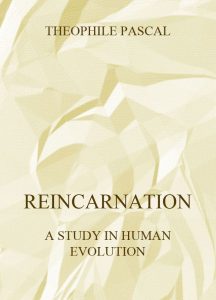Reincarnation – A Study In Human Evolution – Theophile Pascal
It it more than 1500 years since the decision of the Council of 543 a.d. condemned to oblivion sublime teachings which ought to have been carefully preserved and handed down to future generations as a beacon amid social reefs; teachings that would have uprooted that frightful egoism which threatens to annihilate the world, and instilled patience into the hearts of such as were being crushed beneath the wheel of the cosmic law, by showing them the scales of Justice inclining to the side filled with their iniquities of bygone times; teachings which would have been welcomed by the masses, and the understanding of which would not have called for any lofty intellectual culture. The key to the secret lies in Evolution, which can be accomplished only by means of the continual return of souls to earth. The subject will be divided into four chapters: (1) The Soul and the bodies. (2) Reincarnation and the moral law. (3) Reincarnation and science. (4) Reincarnation and the religious and philosophical concensus of the ages.
Format: Paperback.
Reincarnation – A Study In Human Evolution.
ISBN: 9783849673000.
Available at amazon.com and other venues.
Conceptual definitions of reincarnation (from wikipedia.com)
The word “reincarnation” derives from Latin, literally meaning, “entering the flesh again”. The Greek equivalent metempsychosis (μετεμψύχωσις) derives from meta (change) and empsykhoun (to put a soul into), a term attributed to Pythagoras. An alternate term is transmigration implying migration from one life (body) to another. Reincarnation refers to the belief that an aspect of every human being (or all living beings in some cultures) continues to exist after death, this aspect may be the soul or mind or consciousness or something transcendent which is reborn in an interconnected cycle of existence; the transmigration belief varies by culture, and is envisioned to be in the form of a newly born human being, or animal, or plant, or spirit, or as a being in some other non-human realm of existence. The term has been used by modern philosophers such as Kurt Gödel and has entered the English language. Another Greek term sometimes used synonymously is palingenesis, “being born again”.
Rebirth is a key concept found in major Indian religions, and discussed with various terms. Punarjanman (Sanskrit: पुनर्जन्मन्) means “rebirth, transmigration”. Reincarnation is discussed in the ancient Sanskrit texts of Buddhism, Hinduism, and Jainism, with many alternate terms such as punarāvṛtti (पुनरावृत्ति), punarājāti (पुनराजाति), punarjīvātu (पुनर्जीवातु), punarbhava (पुनर्भव), āgati-gati (आगति-गति, common in Buddhist Pali text), nibbattin (निब्बत्तिन्), upapatti(उपपत्ति), and uppajjana (उप्पज्जन). These religions believe that this reincarnation is cyclic and an endless Saṃsāra, unless one gains spiritual insights that ends this cycle leading to liberation. The reincarnation concept is considered in Indian religions as a step that starts each “cycle of aimless drifting, wandering or mundane existence”, but one that is an opportunity to seek spiritual liberation through ethical living and a variety of meditative, yogic (marga), or other spiritual practices. They consider the release from the cycle of reincarnations as the ultimate spiritual goal, and call the liberation by terms such as moksha, nirvana, mukti and kaivalya. However, the Buddhist, Hindu and Jain traditions have differed, since ancient times, in their assumptions and in their details on what reincarnates, how reincarnation occurs and what leads to liberation.
Gilgul, Gilgul neshamot or Gilgulei Ha Neshamot (Heb. גלגול הנשמות) refers to the concept of reincarnation in Kabbalistic Judaism, found in much Yiddish literature among Ashkenazi Jews. Gilgul means “cycle” and neshamot is “souls”. Kabbalistic reincarnation says that humans reincarnate only to humans and to the same sex only: men to men, women to women.
(The text of the last section was taken from a Wikipedia entry and is available under the the Creative Commons Attribution-ShareAlike License.)
Publisher’s Note: This book is printed and distributed by Createspace a DBA of On-Demand Publishing LLC and is typically not available anywhere else than in stores owned and operated by Amazon or Createspace.

